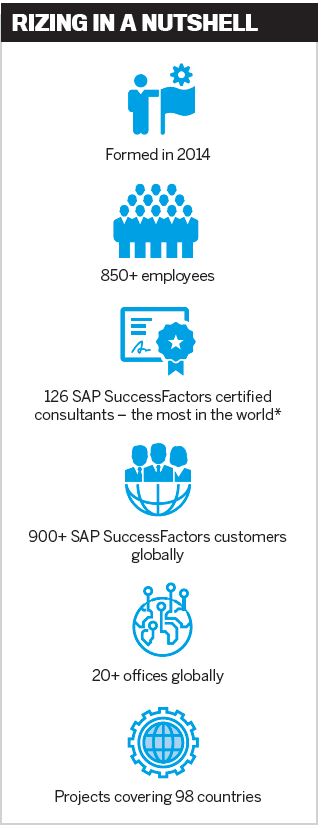
Data is a powerful tool for enhancing the customer experience – but what if it’s also used to enhance the employee experience? HRD talks to Synchrony Global, a Rizing HCM company, to find out more

The last few years have been a wild ride for Synchrony Global, a Rizing HCM company. In that time, the company has built itself into one of Australia’s premier cloud HR and payroll providers for ‘mid-market’ organisations with 100–2,000 employees – in no small part thanks to its association with SAP® SuccessFactors®, and then subsequently its acquisition by Rizing LLC.
“As one of the fastest-growing SAP partners and recipient of the SAP SuccessFactors Partner of the Year award for Australia and New Zealand in 2018, we could not be more thrilled to bring Synchrony into the Rizing HCM family,” says Luc Hédou, CEO of Rizing HCM. “By leveraging the broader organisation, we can accelerate growth and innovation for our customers, both in the region and globally.”
The company’s growth has been rapid, as the implementation of cloud HR and payroll has become an increasingly crucial part of many organisations’ HR strategies. Synchrony stands out from the crowd by specialising exclusively in SAP SuccessFactors and SAP HCM product portfolios – to which it is now adding the experience management solution SAP Qualtrics.
“One of our big focuses moving ahead is how both employee experience data and operational data management and analytics fit into the HR process,” says Mike Ellis, executive vice president of sales for Rizing HCM’s APAC region. “Businesses need to be looking at trends both past and future to formulate better strategies. We are now in the position to help HR understand how their people strategy impacts business.”
 “Technology should play a strategic role in the company’s growth and enable a culture of success in the process” Nico Hadj-Blaha, VP of sales for Australia New Zealand, Synchrony Global
“Technology should play a strategic role in the company’s growth and enable a culture of success in the process” Nico Hadj-Blaha, VP of sales for Australia New Zealand, Synchrony GlobalEnhancing the employee experience
Of course, data needs to be applied within a wider context to be effective. Nico Hadj-Blaha, VP of sales for Australia New Zealand at Synchrony Global, says HR departments need to cultivate a “culture of success” within their organisations.
“We design our solutions with the understanding that HR technology has an impact beyond just automation and cost reduction,” Hadj-Blaha explains.
“Technology should play a strategic role in the company’s growth and enable a culture of success in the process.”
Hadj-Blaha points to the fact that a key Synchrony feature is the provision of a central view of employees. In turn, this provides support for organisational data, personal data, time off and payroll, with full employee life cycle support. Synchrony’s solutions also support recruitment, onboarding, employee engagement, learning and development, employee performance management, compensation, and employee succession and development.
Hadj-Blaha is also keenly aware of the important role these technologies can play in enhancing the employee experience. While businesses have tended to focus data collection on reaching customers more effectively and improving their experience, Hadj-Blaha notes that many businesses need to see a closer connection between employee experience and customer experience. Solutions such as SAP SuccessFactors and SAP Qualtrics can provide key insights.
“The real value to data collection tools like this is being able to gather information around employee satisfaction, then engage with dissatisfi ed employees at the right time to address any issues,” says Hadj-Blaha.
When businesses talk about improving their services for customers, there are four key metrics that tend to be assessed, explains Hadj-Blaha – customer experience, brand experience, product experience and employee experience.
“When looking to understand the past, current or future success of an organisation,” he says, “it is imperative to be looking at employees’ experience metrics too.”
It’s a way of providing touchpoint surveys and analytics for HR, he notes. With the vast bulk of business cases being built on tangible benefits, these forms of data tracking enable more effective KPIs to be created and accordingly help paint a picture of a more effective return/investment analysis. It’s more agile overall.
“When you look at the HR life cycle, there are often facets which, on paper, are more difficult to track,” says Hadj-Blaha. “But tools like SuccessFactors – and the subsequent data analysis from Qualtrics –allow HR departments to measure the realtime impact of the employee experience on customer satisfaction.”
He points to a recent example involving a major airline client. Customer satisfaction on the overnight Melbourne–Denpasar flight path was at an all-time low, and a closer scrutiny of the situation revealed that the employees working these shifts were also deeply unhappy. Revenue was being negatively impacted, with many passengers choosing to fly other airlines. The technology provided these insights, but the solution, notes Hadj-Blaha, was a relatively simple human one.
“Qualtrics helped identify that most of the issues stemmed from the airline charging for a blanket, which passengers and staff alike felt was unfair for an overnight fl ight,” says Hadj-Blaha. “The airline began providing overnight blankets for free – once this was done, customer complaints went down and employee satisfaction went up.”
It’s situations like these which highlight the importance of the human facet of the employer-employee interaction, notes Hadj-Blaha.
“The technology is going to give management a real-time indicator of what is happening on the ground, but you need to have conversations beyond that too,” he says. “Upper management does not always know when to have these conversations, but the output of tech like this can be useful for helping determine when the best time might be.”
Engagement with employee engagement
Ellis is also quick to point out that employee engagement surveys and initiatives aren’t new.
However, their ability to gauge trends in real time has frequently been limited – typically, because of the work required to analyse the data.
“Realistically, HR needs to go beyond simple analytics – there also need to be expert action plans and advice,” he says. “Tools like this ultimately make HR more relevant as part of the overall business strategy.”
He also notes the importance of gaining genuine and honest insights from employees. Issues such as increased absenteeism or general dissatisfaction are not always easily identifiable if employees don’t feel they can be open and honest.
“Data acquired through SuccessFactors and Qualtrics can be anonymous or include full staff details,” says Ellis. “It’s really up to the individual employer, and sometimes even the circumstances of employment.”
Ellis also explains that the integration of SAP Qualtrics with SuccessFactors facilitates machine learning, allowing for analysis of open text. Something that was once manual and cumbersome to process outside of the solution can now be automated to reveal previously hidden insights.
“We’re looking to add support for this in the near future,” says Ellis. “Thanks to Qualtrics’ machine learning capabilities, it’s something that we think is quite achievable. We expect it to be of significant use to companies who may be looking to better analyse their historic performance data to help predict future outcomes.”
Building from the baseline
There’s still more innovation on the horizon, too. Rizing is helping Synchrony stay true to its roots, while innovating and expanding its People and Payroll solutions into new territories.
“The Synchrony team is looking forward to rebranding to Rizing in October this year,” says Ellis. “As Rizing, we have the global structure and experience to take HCM solutions to the next level. Rizing will allow us to better segment and deliver our products and services to SMB, mid-market and enterprise clients, with simple and cost-effective packaged solutions which are relatively easy to adopt, right though to our industry-leading functional and technical services for largescale implementations.”
.jpg)
As part of Rizing, LLC, the Rizing HCM line of business is headquartered in Montreal, Quebec. Rizing HCM is one of the strongest partners in the SAP SuccessFactors ecosystem through its combined end-to-end experience and leading number of global implementations. With the addition of Synchrony Global, Rizing HCM has over 900 customers, making it one of the largest, and most qualified, SAP SuccessFactors consulting firms in the world.